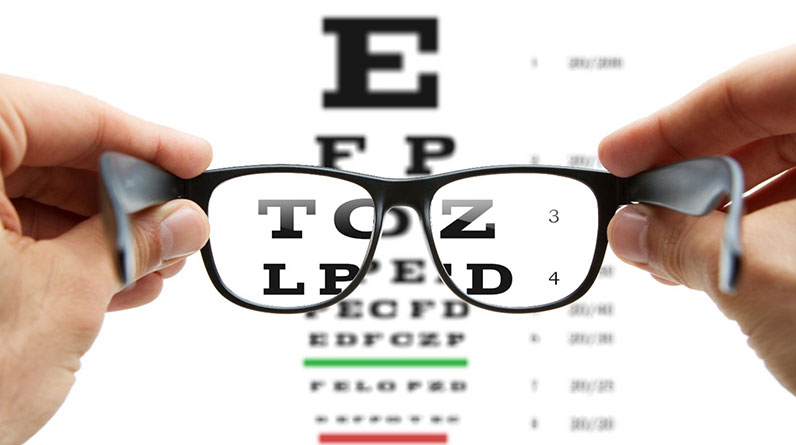
Causes and Development of Presbyopia
Presbyopia is a natural part of the aging process that affects nearly everyone as they reach middle age. It occurs when the lens of the eye gradually loses its flexibility, making it more difficult to focus on close objects. Here’s a look at how presbyopia develops:
1. Natural Aging Process
Presbyopia typically begins to manifest between the ages of 40 and 45. As we age, the lens of the eye, which is responsible for focusing light onto the retina, becomes less flexible. This loss of flexibility impairs the eye’s ability to adjust its focus, particularly when switching from distant to near objects. As a result, close-up tasks like reading or using a smartphone become more challenging.
2. Changes in the Eye’s Lens Flexibility
The lens of the eye is usually soft and flexible, allowing it to change shape easily and focus light at various distances. However, with age, the proteins in the lens harden, making it less able to bend and focus. In addition to the lens itself stiffening, the muscles surrounding the lens may also weaken, further reducing the eye’s focusing ability.
3. Onset Age and Common Symptoms
The onset of presbyopia typically begins in the early 40s and becomes more pronounced as one ages. Common symptoms include the need to hold reading materials at arm’s length, difficulty reading small print, eye strain, and headaches when doing close-up work. As presbyopia progresses, these symptoms become more noticeable, and reading glasses or other corrective measures may be required to improve near vision.
Options for Correcting Presbyopia
Several options are available to correct presbyopia and restore clear near vision, ranging from simple reading glasses to advanced surgical procedures. Depending on the severity of the condition and personal preferences, individuals can choose the option that best suits their lifestyle and vision needs.
1. Over-the-counter (OTC) Reading Glasses
OTC reading glasses are a convenient and affordable solution for many people with presbyopia. These non-prescription lenses are available in various strengths, typically ranging from +1.00 to +3.50 diopters, and can be purchased at pharmacies or retail stores.
OTC readers work well for individuals with mild presbyopia and no other significant vision problems, offering a quick fix for reading or close-up tasks. However, they do not correct for differences between the two eyes or other refractive errors like astigmatism, so they may not be ideal for everyone.
2. Prescription Reading Glasses
For those with more complex vision needs, prescription reading glasses provide a customized solution. An eye care professional can determine the exact lens strength and correct for other refractive errors, such as astigmatism or nearsightedness, in addition to presbyopia.
Bifocal or progressive lenses are also available in prescription reading glasses, allowing for both near and distance vision correction in one pair of glasses. These glasses are particularly useful for individuals who need to switch frequently between close-up and distant tasks.
3. Contact Lenses
Contact lenses are another option for correcting presbyopia, and several types are available. Multifocal contact lenses, which provide different zones for near and distant vision, are commonly used for presbyopia.
Some individuals may also benefit from monovision contact lenses, where one lens is fitted for near vision and the other for distance. While effective, contact lenses require proper care and regular eye exams to ensure eye health and comfort.
4. Surgical Options
For those seeking a more permanent solution, surgical options are available to treat presbyopia. One such procedure is Laser-Assisted In Situ Keratomileusis (LASIK), which can create a multifocal effect on the cornea to improve near vision. Another option is Corneal Inlays, where a small implant is placed in the cornea to enhance near vision while maintaining distance vision.
Lens replacement surgery (similar to cataract surgery) involves removing the eye’s natural lens and replacing it with an artificial intraocular lens (IOL) that can correct both near and distant vision. While surgery offers lasting correction, it comes with risks and recovery time, making it important to consult with an eye specialist to determine if it’s the right option.
While presbyopia is a natural part of aging that cannot be entirely prevented, certain lifestyle changes and habits can help delay its onset and minimize its impact on daily life. Taking proactive steps to care for your eyes and overall health can preserve vision quality as you age. Be sure to maintain good eye habits, eat a healthy diet, exercise regularly, wear proper eyewear, and seek out regular check-ups.
Presbyopia is an inevitable part of the aging process that affects nearly everyone over time, making it harder to focus on nearby objects. As the eye’s lens loses flexibility, tasks like reading, working on a computer, or even seeing your phone screen can become challenging.
Though presbyopia is natural, its symptoms can be frustrating and disruptive to daily life. Fortunately, there are many effective options for managing presbyopia, from reading glasses and contact lenses to advanced surgical treatments. With proper care, lifestyle adjustments, and regular eye exams, individuals can manage presbyopia effectively and continue enjoying good vision well into their later years.
